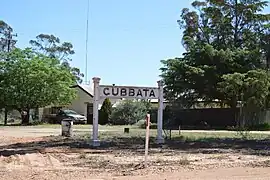Gubbata
Gubbata is a locality in the Central West region of New South Wales. The locality is in the Bland Shire local government area 432 kilometres (268 mi) west of the state capital, Sydney.
| Gubbata New South Wales | |
|---|---|
 The platform sign from the former Gubbata station | |
 Gubbata | |
| Coordinates | 33°38′0″S 146°33′0″E |
| Postcode(s) | 2669 |
| Location |
|
| LGA(s) | Bland Shire |
| County | Dowling |
| Parish | Blairgowrie |
The area now known as Gubbata, lies on the traditional lands of the Wiradjuri people.[1] The name, Gubbata, is most likely a settler rendering of an Aboriginal language word.
The Village of Gubbata was proclaimed in December 1930,[2] around the time that the surrounding area was opened up for farming[3] and the railway line was opened.[4] Some of the new farming blocks were reserved for soldier settlers.[5] It never grew to the expectations held for it in the early 1930s, Nonetheless, there was a small settlement established there.[3]
It is on the Naradhan Railway Line. The station opened 11 Feb 1929 and closed to passengers 4 May 1975. There was a siding with a loading bank,[4] but the nearest bulk grain silo was built adjacent to the next station, at Kikoira, in 1933.[6]
Gubbata had a public school, from June 1934 to 1946, and again, from September 1961 to February 1983.[7] It also had a post office, by 1934,[8] which closed on 31 July 1981. Like many small communities, it had a public hall.[9][10]
Mines in the area included two underground gold mines, the Blairgowrie Mine[11] and the Gubbata Mine just off the Naradhan Road.[12][13] However, the discovery of tin nearer to the neighbouring village of Kikoira, in 1938, led to that village becoming a larger and longer-lasting settlement than Gubbata. Little now remains of the village.
As the village was surveyed and only partially settled, the native scrub in the village reserve was left largely intact while the surrounding area was cleared for agriculture. This remnant area is the basis of the Gubbata Nature Reserve. The reserve is dominated by pointed mallee, congoo mallee and yorrel. Some spinifex and scrub cypress are also present. "The reserve is managed to maintain the sample of mallee habitats in an area that is largely cleared, which requires minimal visitation."[14]
Gubbata's highest recorded temperature is 46.2°C and its lowest -4.8 °C. Rainfall is between 30 millimetres (1.2 in) and 40 millimetres (1.6 in) year round.,[15] and an altitude of about 204 metres (669 ft) above sea level.
References
- Studies, Australian Institute of Aboriginal and Torres Strait Islander (10 January 2021). "Map of Indigenous Australia". aiatsis.gov.au. Retrieved 6 March 2022.
- "VILLAGE OF GUBBATA". Government Gazette of the State of New South Wales. 19 December 1930. p. 5027. Retrieved 27 February 2022.
- "GUBBATA". West Wyalong Advocate. 18 April 1930. p. 2. Retrieved 27 February 2022.
- Gubbata station.
- "THE FUTURE TOWNSHIP". West Wyalong Advocate. 4 June 1929. p. 1. Retrieved 27 February 2022.
- "Completion of Silo System Is Now Well in Sight". The Land. Sydney: National Library of Australia. 7 July 1933. p. 5. Retrieved 12 January 2014.
- "Gubbata". nswgovschoolhistory.cese.nsw.gov.au. Retrieved 27 February 2022.
- "GUBBATA ROBBERY". West Wyalong Advocate. 12 January 1934. p. 7. Retrieved 27 February 2022.
- "GUBBATA HALL". West Wyalong Advocate. 12 September 1930. p. 6. Retrieved 27 February 2022.
- "Christmas Tree And Party At Gubbata Hall". West Wyalong Advocate. 16 December 1954. Retrieved 27 February 2022.
- Downes, P., NSW Metallic Mineral Occurrence Database. (NSW Department Of Mineral Resources,1997)
- Heugh, J., Mirlis/Metallogenic Mine Data Sheets - Cargelligo-Narrandera 1:250k Sheet Area. (Geological Survey Of Nsw, Department Of Mineral Resources, 1980).
- "Map of Gubbata in New South Wales - Bonzle Digital Atlas of Australia". www.bonzle.com. Retrieved 6 March 2022.
- Gubbata Nature Reserve.
- Gubbata Nature Reserve - Climate
External links
![]() Media related to Gubbata at Wikimedia Commonsw
Media related to Gubbata at Wikimedia Commonsw